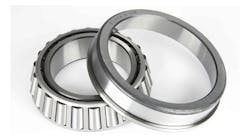From rapid to industrial prototyping, Hoffman helped Hella execute breakthrough design for Porsche lighting
Automotive lighting is an interplay of function and design, and in recent model years it has taken on increasing importance to designers. For the new Porsche Macan, Hella — which develops automotive lighting and electronics systems — originated rear lighting system with light strips for guiding LED light. The functional principle of these patented "Edgelights" in a strip-form signal light is a breakthrough: Using this approach, the signal light can be integrated flexibly and in a space-saving way into the outer skin of the vehicle body.
The heart of the brake light is a thick-walled part made of PMMA, which is the light module or light strip. This part has a complex, prismatic geometry and reflective qualities for light projection. It was developed in partnership with Hofmann Innovation Group, a tool and model maker. The light module also required the production team at Hella to fulfill high standards in production quality. A thick-walled, distortion-free PMMA body was needed.
Edgelights are complex light strips for rear lighting systems. In combination with other individual parts, Edgelights are part of the safety-relevant functioning of the brake lights in the rear lighting system of a vehicle. The design for the Porsche Macan chosen by Hella consists of three component groups.
In addition to the "Edgelight" light modules, the rear light component groups consist of other components usually found in rear lights. This includes lenses made of PMMA in four colors (red transparent, transparent gray, opaque black, and transparent light red), which are injection molded using a three-step process. The heavily tiered external contour of the upper light lens is unusual.
Demanding parts require partnership over the entire life cycle. The Hoffman Innovation Group — which builds models and tools for plastics production — generally gets involved as early as the initial development stages, and contributes to the design of series tools and production processes.
"The light module is subject to high expectations in terms of design, surface look and function," explained Friedrich Vosswinkel, project manager at Hofmann. At the same time, the customer expects a design which is optimized for plastics and that ensures process stability during production, and is completely distortion-free."
In this regard, Hofmann offered trial and pilot production in its state-of-the-art technical center in Lichtenfels, Germany. "The higher the requirements for a component are set, the more conservative the view of the production team concerning stable processes," according to Vosswinkel.
Hella manufactures the series-production Edgelights from transparent PMMA on turning tools, as multi-component parts, using a two-step process. Each tool produces a left-hand and a right-hand component in each cycle. They are pre-injected and finish-injected using Hoffman’s distortion-proof 2K technology. Here, the challenge for production is in the correct geometrical forming and absolute cleanliness of the Edgelights. These requirements are essential to allow the light beams to shine with the desired intensity. After cooling down, the light modules are delivered as individual parts to the rear light production facility.
In order to achieve the required light values, the thick-walled PMMA part, which is made of Altuglas HT 121 or Plexiglass 8N, requires the highest standards in the 2K process for the seams.
A further factor is the highly complex "prism geometry" for the entry and exit of the LED light. As part of tool development, it was the task of the tool maker, Siegfried Hofmann, to develop a 3D contour that would allow maximum light output at the point of emission and at the same time be manageable from a production technology point of view. This applied not only to the manufacture of the series-production tools, but also to the demolding characteristics of the light module in the tool, as well as the manageability of the process in terms of strict absence of distortion. "The function of the light module demands that the component be completely distortion-free, which is a challenge for us as tool designers, and for production at Hella", Friedrich Vosswinkel added.
There are two types of model making in product development: rapid prototyping and industrial prototyping. Rapid prototyping means: for the rear lights of the Porsche Macan, Hella needed prototypes from Robert Hofmann in order to test them and for consultation and approval from their customer Porsche. This highly dynamic consultation process required constant adaptation to design wishes and modified functional requirements. These prototype parts, which are equivalent to series-production parts, are developed using model making methods. Initially they are built as individual components, and later as rear lights built into pre-production cars.
The methods included pouring the "Edgelight" light modules with PMMA, and CNC milling of the light entry and exit geometries in order to achieve continuous improvement of the light parameters. EMU samples were made for the complete rear light module component group, using STL technology (stereo lithography), laser sintering for plastics, aluminum processing and vaporizing of the reflectors. In addition, vibration welding was used and testing materials supplied for the subsequent small batch.
With regards to small batch production, after the development and modeling phase, "Industrial Prototyping" comes into play. Porsche needs demonstration vehicles from pilot production runs for presentation at trade fairs or for dealer presentations. These vehicles correspond to production vehicles in terms of function, but some model parts are used in them. In total, Hofmann delivered 300 sets of rear lights (right and left) before start of production.








